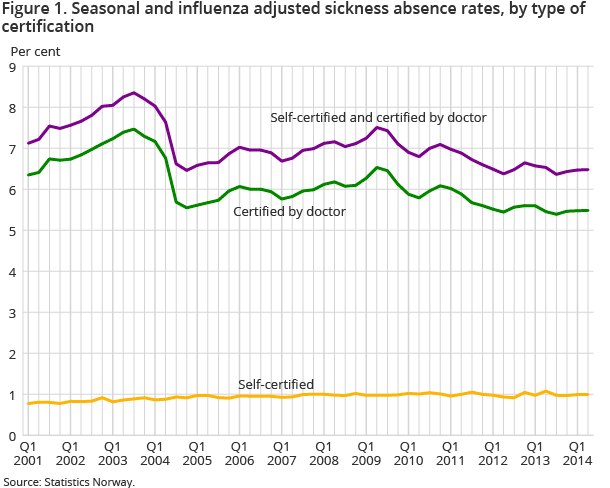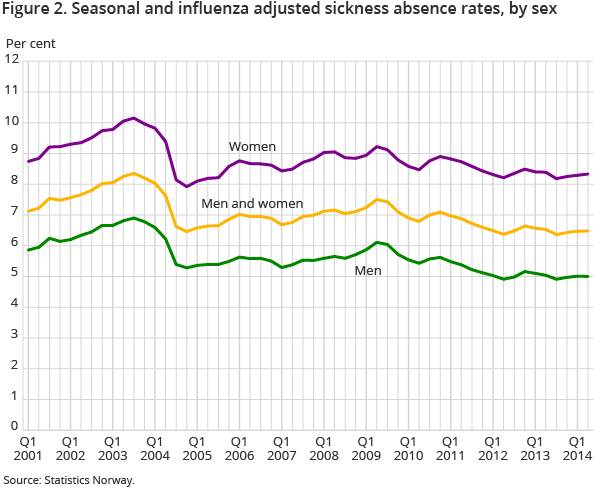Content
Published:
This is an archived release.
Seasonally-adjusted sickness absence still stable
Sickness absence adjusted for seasonal and influenza variations was 6.5 per cent in the 2nd quarter of 2014, almost unchanged from the 1st quarter of 2014.
| 2nd quarter 2014 | Per cent from previous quarter | |
|---|---|---|
| 1The sickness absence rates are shown to two decimal points. In other tables the rates are shown with one decimal point. More decimal points are used when calculating the rates of change in order to get more accurate figures. These will therefore differ slightly from the rates of change produced when using the published rounded figures. | ||
| Both sexes | ||
| Self-certified and certified by doctor | 6.48 | 0.1 |
| Self-certified | 0.99 | 0.1 |
| Certified by doctor | 5.48 | 0.1 |
| Males | ||
| Self-certified and certified by doctor | 5.00 | -0.2 |
| Self-certified | 0.87 | -0.8 |
| Certified by doctor | 4.13 | -0.1 |
| Females | ||
| Self-certified and certified by doctor | 8.33 | 0.4 |
| Self-certified | 1.15 | 1.0 |
| Certified by doctor | 7.18 | 0.3 |


Both the self-certified and the doctor-certified absence had a marginal rate of increase by 0.1 per cent from the 1st quarter of 2014 to the 2nd quarter of 2014. Sickness absence for men fell by 0.2 per cent, while rising 0.4 per cent for women.
Since the 2nd quarter of 2001, when the agreement on an inclusive labour market, IA agreement , was first implemented, the seasonal and influenza-adjusted sickness absence has dropped by 10.2 per cent.
Statistics without seasonal and influenza adjustment
Since the following comments are based on data that is not adjusted for seasonal and influenza variations, we look at changes over the past year, from the 2nd quarter of 2013 to the 2nd quarter of 2014.
Sickness absence that is not adjusted for seasonal and influenza variations was 6.0 per cent in the 2nd quarter of 2014; an increase of 0.5 per cent from the previous year. The self-certified sickness absences decreased by 6.8 per cent, while the doctor-certified sickness absence increased by 1.7 per cent.
Sickness absence for men and women was 4.6 and 7.8 per cent respectively in the 2nd quarter of 2014. The rates of change show a minor increase of 0.4 per cent for both sexes last year.
The figures that are adjusted for seasonal and influenza variations show a minor decrease last year. The reason is that Easter was in the 2nd quarter of 2014 and in the 1st quarter of 2013. Since we do not have seasonally-adjusted numbers for the groups mentioned below, we do not have a precise estimate of the Easter effect. The relative conditions between the groups will, however, not be affected by this, but figures showing a fall will generally be underestimated and figures showing an increase will be overestimated.
Same level for both men and women last year
Sickness absence for both men and women remained almost unchanged last year at - 4.6 and 7.8 per cent respectively, but a detailed look shows a slight increase of 0.4 per cent for both sexes.
Increase in sickness absence in local government
Sickness absence in local government rose by 2.0 per cent from the 2nd quarter of 2013 to the 2nd quarter of 2014. Absence in public administration (including health enterprises) and the private sector had a minimal decrease of 0.4 and 0.1 per cent respectively.
The sickness absence level in the 2nd quarter of 2014 was lowest in the private sector with 5.5 per cent, while central and local government had an absence rate of 5.8 and 8.0 per cent respectively.
Increase in real estate and technical activities
Among the major industries, the real estate and technical activities together with the information and communication industry had the largest increase in sickness absence of 4.3 and 4.0 per cent respectively. Absence in the health and social work activities industry had the largest decrease of 1.3 per cent.
Decrease among the youngest
For both men and women, the doctor-certified absence had the strongest reduction in the age groups 20-24 and 25-29 years. The absence for women declined by 4.3 and 0.8 per cent respectively, while the absence for men decreased by 3.7 and 2.5 per cent respectively.
These results are based on data on sickness absence certified by a doctor, as the survey on self-certified absence does not contain data on sickness absence by age.
Contact
-
Arbeidsmarked og lønn
E-mail: arbeidsmarked@ssb.no
-
Unn H. Høydahl
E-mail: unnh.hoydahl@ssb.no
tel.: (+47) 40 90 23 77
